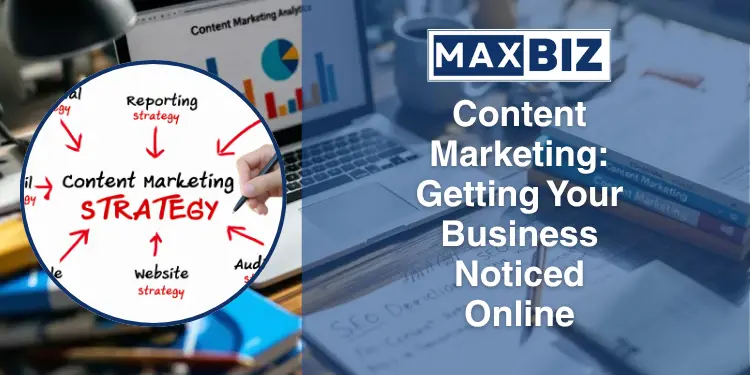Content marketing means sharing useful material to attract and keep a specific audience. It includes blogs, videos, infographics, and eBooks. Studies show 44% of buyers look at several pieces of content before contacting a business.

This method costs less than traditional ads for getting leads.
Well-crafted content enhances brand awareness and increases revenue. It helps connect with people and builds trust with the audience. Using search engine optimisation (SEO) enhances website rankings and draws in valuable visitors as well.
What is Content Marketing?
It is the online sharing of written and visual material. This can include blogs, videos, infographics or web pages. It aims to attract interest and generate leads.
Crafting compelling narratives plays a big part in this approach. Instead of pushing products, it pulls people in by offering useful or engaging content.
The Importance of Content Marketing in Today’s Digital World
Content marketing has become an essential tool for businesses. Over 29% of companies are expected to utilize it in 2025. Developing blogs, videos, and social media posts fosters trust with an audience.
Blogging by itself generates 85.19% of organic search traffic, highlighting its importance in online achievement.
Video content remains a significant trend. Approximately 91% of companies rely on video marketing today. It captivates audiences and enhances lead generation more affordably. Businesses prioritising compelling online content experience over three times more leads than outbound methods while also reducing costs by up to 62%.
Strategies for Effective Content Marketing

Identify your audience first. Understand their needs, interests, and problems. Tailor content to solve their issues or entertain them.
Create a thoughtful strategy for posting. Use blogs, videos, infographics, and social media posts. Enhance visibility with well-researched keywords. Share content across various platforms to expand reach.
Consistently provide value to nurture trust and loyalty over time.
Identifying Your Target Audience
Understand the individuals you are communicating with. Researching your target audience assists in aligning content marketing with buyer personas. It involves steps like customer segmentation and audience profiling.
These identify specific groups based on characteristics such as age, location, or purchasing behaviour.
Customised marketing strategies are more effective when you have a strong understanding of your audience. Utilise tools for target market analysis and data collection to shape your strategies.
This results in improved content targeting and deeper relationships with customers.
Creating a Content Marketing Plan

Creating a content marketing plan helps businesses reach their goals. It ensures all steps are well-organised and effective.
- Set SMART Goals
Focus on Specific, Measurable, Achievable, Relevant, and Time-bound goals. For example, increase website traffic by 20% in three months.
- Identify Your Target Audience
Learn who your audience is and what they need. Use surveys or tools to gather insights about age, interests, or location.
- Choose Key Content Types
Decide if you will create blogs, videos, infographics or social posts. Blogging can improve search engine rankings while social media fosters interaction.
- Create a Detailed Content Calendar
Plan when and where to post content each month. Prioritise popular times for posting on platforms like Instagram or Facebook.
- Enhance Content with SEO Techniques
Use relevant keywords and meta descriptions for better visibility online. Include keywords such as “digital marketing” or “target audience.”
- Analyse Performance Metrics
Measure clicks, shares or sign-ups from your content efforts. These metrics show which strategies are working best.
- Consistently Revisit Quality Content
Regularly deliver useful and appealing material tailored to your audience’s needs.
- Refine Strategies Using Analytics Tools
Study the data from tools like Google Analytics to modify approaches if needed for improved results over time.
Types of Content Marketing
A well-thought-out strategy leads to effective content. Blog posts inform readers and help drive website visits. Social media posts enhance interaction with followers. Videos share stories in an engaging manner while capturing attention.
Infographics present information clearly, making details simple to grasp quickly. Email newsletters keep audiences informed about products or updates. Podcasts deliver expert insights or provide valuable advice.
Webinars link your brand with viewers through live discussions.
Blogging
Blogging helps attract organic search traffic. It accounts for 85.19% of all blog visits from natural search results. Writing travel tips or hotel recommendations, like Expedia does, can captivate readers looking for advice online.
Consistent article creation enhances web traffic and strengthens a strong online presence.
Enhancing blogs with optimisation strategies increases visibility in search results. Valuable posts draw in more visitors and reinforce online marketing initiatives.
Video Content
Blogging helps connect deeply with readers, but visual content communicates effectively. Online videos are now integral to storytelling and video marketing strategies. Over 91% of businesses use them to better connect with audiences (Wyzowl research).
A good example is Dollar Shave Club’s humourous, widely-shared videos that made their brand distinct.
Videos work well for social media campaigns or product tutorials. They bring ideas alive through motion graphics and multimedia content. Brands can tell stories efficiently and create lasting impressions with impactful video production.
Social media platforms like Instagram excel with short, shareable clips that quickly capture attention.
Infographics
Infographics transform intricate data into straightforward visuals. They utilise charts, graphs, and icons to convey a narrative efficiently. For instance, HubSpot’s infographic on blog subscriber strategies effectively outlines steps and advantages.
Visual storytelling captures attention swiftly. Infographics enhance the comprehension of data while increasing understanding significantly. Businesses frequently share them online for stronger interaction on social media or websites.
Social Media Posts
Social media posts enhance online interaction and strengthen digital branding. Use captivating content to grab attention swiftly. Platforms like TikTok are effective for showcasing creative concepts.
Chipotle engages with audiences through entertaining videos about recipes. Businesses can also partner with content creators to expand their reach to new audiences.
Well-crafted social media strategies improve consumer outreach and online visibility. Digital promotions or special offers keep followers engaged. Social networking fosters a personal connection with your audience, setting the stage for blogging strategies to follow.
SEO and Content Marketing
SEO and content marketing collaborate to enhance website visibility in search results. High-quality content incorporates well-researched keywords, aiding search engines in easily locating your site.
Onpage SEO focuses on creating a clear website structure, while offpage SEO involves acquiring links from reputable sources. Both approaches boost unpaid traffic, vital for sustained growth over time.
Only a small percentage of online content receives organic search traffic (Ahrefs). Content should align with user needs to make an impact. Blogging, video production, or social media updates should adhere to an effective content approach.
Search engine optimisation strengthens this approach by increasing relevance and prominence in digital marketing efforts.
Tools and Technologies for Content Marketing
Content management systems like HubSpot assist in arranging and distributing material. Tools such as Google Trends monitor marketing patterns, ensuring strategies remain current.
Canva simplifies the process of designing visuals for online sharing. Social media tools, like Buffer and Sprout Social, organise post schedules to optimise time. Software like Mailchimp manages email campaigns seamlessly.
Trello supports efficient task coordination for team projects.
Content Management Systems (CMS)
CMS helps manage and publish website content efficiently. Platforms like WordPress, Joomla, or Wix enable users to design pages, schedule posts, and update information without needing coding expertise.
Digital publishing platforms simplify tasks for marketers. With tools like HubSpot’s AI Content Writer, teams can produce blogs or social media posts more quickly. These systems also enhance online content management by ensuring everything is structured in one central location.
SEO Tools
A good CMS is only the start. SEO tools enhance your content’s visibility on search engines. They simplify keyword analysis, revealing popular search queries online. Tools like Google Trends and Ahrefs identify trending terms to focus on in your content.
SEO tools also monitor your website’s performance in search engine results. Utilise these platforms to analyse backlinks and refine both on-page and off-page SEO strategies. They also assist in improving meta tags for enhanced organic search outcomes.
Frequent updates ensure your site remains optimised for peak performance!
Analytics and Reporting Tools
SEO tools help attract visitors to your content. Analytics and reporting tools demonstrate how effectively that traffic behaves. Tools like HubSpot track important performance metrics such as user activity, website visits, and successful actions.
They also offer data visualisation for better clarity.
Platforms such as Trello or Asana ensure teams stay organised with content projects. These project management tools simplify the process of monitoring deadlines and tracking metrics in a central location.
Reporting dashboards highlight patterns over time, enabling quick adjustments to strategies for improved outcomes.
Social Media Management Tools
Social media management tools assist in organising and sharing content effectively. They ensure your posting schedule remains reliable. Tools like Buffer and Sprout Social allow you to handle several platforms in one place.
These tools save time by automating tasks.
Social media analytics tools evaluate the performance of posts. This information aids in refining strategies promptly. Monitoring tools observe comments, mentions, and trends to enhance interactions.
Next, delve into successful content marketing examples to observe tangible outcomes!
Content Marketing Success Stories
Expedia’s travel blog shares tips for travellers and fun stories. This simple effort attracts significant traffic to their site. Dollar Shave Club created a humorous and widely-shared video that significantly boosted brand recognition in a short time.
Millions watched it, contributing to their rapid growth.
Chipotle effectively uses TikTok by sharing videos showcasing their menu items. Their account now has over 2.3 million followers interacting with them daily. Spotify demonstrated the impact of tailored content with “Wrapped” in 2022, where 90 million users shared music stats online! These examples highlight how diverse types of content can capture attention and foster meaningful connections with people successfully.
Case Study 1: A Small Business That Thrived Through Blogging
A small business in Australia used blogging to grow fast. The company shared useful tips and advice related to its services. This attracted readers searching for such topics online.
Their blog posts boosted organic search traffic, increasing website visits by 120% within a year. By posting weekly and using engaging stories, they kept their audience captivated.
Through smart keyword use and regular updates, the business also achieved better visibility on search engines like Google. Blogging became their leading source of new leads without additional advertising costs.
Blogs addressing common customer problems established trust with readers too. Small businesses can follow similar strategies under “Types of Content Marketing” next.
Case Study 2: A Brand That Gained Popularity Through Social Media
Blogging helped some businesses grow, but others found success on social media. Chipotle built a strong online presence using TikTok. They gained over 2.3 million followers and 53 million likes with creative and widely shared content.
Their strategy included collaborations with well-known creators and campaigns encouraging user participation. This enhanced customer interaction and brand exposure rapidly. Social media impact played a significant role in their online marketing efforts, advancing their digital brand promotion further.
Challenges in Content Marketing
Keeping content relevant and engaging is a big challenge. Audiences want fresh ideas, not repetitive or dull material. Businesses must stay updated and align with what their target audience values most.
Out of all content created, only 3.45% gets organic search traffic. This highlights the importance of comprehensive search optimisation strategies to enhance visibility.
Effective content distribution is another hurdle. Using owned platforms like blogs or social media helps but isn’t enough on its own. Collaborating with other sites ensures wider reach and better results.
It’s also crucial to build trust by offering genuine value rather than just promoting products or services repeatedly without purpose or connection to user needs.
Keeping Content Relevant and Engaging
Crafting appropriate material maintains reader interest. Use straightforward language and concentrate on their priorities. Updated content attracts interest and encourages return visits.
Make sure your topics align with current issues or developments.
Regular updates are important. Old posts lose relevance quickly—viewers might move on. Create captivating material that addresses concerns, entertains, or provides clear information.
Maintain audience focus with brief, helpful content that remains current and engaging.
Measuring the Success of Your Content Marketing Efforts
Track goals like website visits or leads to gauge success. Use tools such as HubSpot’s analytics to examine performance data. Scrutinise metrics like page views, bounce rates, and time spent on pages for insights.
Monitor search engine rankings and calculate keyword impact over time. Quantify social media shares, likes, and comments to assess interaction.
Evaluate the effectiveness of blog posts or videos by analysing the return on investment. Examine email interaction rates if campaigns are used. Regularly evaluate strategies by comparing results against set targets.
Revise plans based on findings for continuous improvement.
The Future of Content Marketing
Content marketing will emphasise the production of helpful and entertaining outputs like blogs, podcasts, and videos. Businesses must consistently provide value to remain visible and trusted.

Owned platforms will be instrumental in strategic distribution, enabling brands to maintain control over how content is delivered to their audience.
Artificial intelligence (AI) is poised to transform the way marketers develop content. AI-powered tools can enhance search engine optimisation efforts, recommend topics more efficiently, or even assist in drafting blogs and posts.
Consumers are seeking tailored experiences throughout their purchasing journey. By deepening audience connections through meaningful interactions, brands build loyalty and trust—essential for sustainable success.
Resources for Content Marketers explores tools to refine strategies further.
Emerging Trends in Content Marketing
Short-form videos lead the way in 2025. Around 30% of marketers plan to use these clips to quickly connect with audiences. TikTok takes center stage, with 56% intending to increase their investment in the platform next year.
Marketing through influencers gains even more momentum. Brands collaborate with creators on social media platforms to rapidly enhance visibility and build trust. Video marketing remains a top trend, combining entertainment and brand promotion seamlessly online.
The Role of Artificial Intelligence in Content Marketing
AI assists in producing content more efficiently. It utilises technologies such as machine learning and natural language processing to generate articles or posts. Approximately 45% of marketers turn to AI for fresh ideas and strategic approaches.
Predictive analytics can analyse user behaviour, enabling enhanced tailored marketing and refined content strategies. Automated content creation not only saves time but also enhances marketing efforts.
Resources for Content Marketers
HubSpot Academy offers free courses to enhance writing skills and refine marketing strategies. Explore topics like blogging, social media, and search engine optimisation. Canva is a great resource for designing visually appealing graphics for content.
Utilise tools like Google Trends for audience insights. Trello and Asana streamline task management effortlessly. Buffer and Sprout Social ensure effective management of social media posts.
StoryChief simplifies content distribution and tracks performance efficiently within a unified dashboard.
Content Marketing
Traditional marketing and content marketing are two distinct approaches. Here’s a detailed comparison outlining their differences comprehensively.
| Aspect | Traditional Marketing | Content Marketing |
|---|---|---|
| Objectives | Focuses on direct selling and promotions. | Aims to attract, captivate, and inform audiences through meaningful content. |
| Strategies | Relies on outbound approaches like TV, radio, and print ads. | Focuses on inbound methods using compelling narratives and digital platforms. |
| Tools and Methods | Uses billboards, cold calls, and direct mail campaigns. | Includes blogs, videos, infographics, social posts, and enhanced website visibility. |
| Engagement | Interaction is often one-way and less personalised. | Promotes interactive conversations with customised, relatable content. |
| Cost | Often expensive with high production and airtime costs. | Costs substantially less while generating significantly more leads. |
| Measurement | Success is gauged by sales numbers and ad reach. | Tracks success using analytics, interaction metrics, and lead generation outcomes. |
| Customer Focus | Centred on products or services being advertised. | Emphasises solving customer problems and delivering value. |
Content marketing has become vital. Its ability to deliver clear results, such as increasing interaction and lead generation, makes it an indispensable tool. The 67% effectiveness rate for B2B marketers in 2023 underscores its importance.
Objectives
The main goals of content marketing are clear. It works to increase brand awareness, foster trust, boost sales, and maintain customer loyalty. Businesses aim to reach targets by sharing valuable and engaging information.
This method transitions from solely promoting products to addressing the audience’s needs. Unlike direct ads, it emphasises creating lasting value through practical content. Each piece serves a purpose—whether it’s strengthening relationships or generating online traffic.
Strategies
Identify your audience first. Understanding their characteristics assists in crafting more effective content strategies. Use inbound approaches such as compelling narratives to attract their attention.
Incorporate diverse techniques such as video marketing, blogs, social media updates, and infographics. Prioritise optimisation strategies to improve your visibility in search results.
Develop campaigns aligned with your objectives and encourage meaningful interactions with users.
Tools and Technologies
Content marketing thrives with the right tools. Content Management Systems (CMS) like WordPress help manage and publish material effortlessly. Tools for search rankings help increase visibility online.
Social Media Management Software organises and tracks posts across platforms. Performance tracking tools highlight what delivers the best outcomes. Such marketing tools simplify tasks while enhancing results.
Engagement and Interaction
Customer engagement fosters trust and loyalty. Emotional connections form when people find genuine value in what they read or watch. Nearly half of buyers, about 44%, review 3 to 5 pieces of material before reaching out to vendors.
Marketing efforts, like blogs or videos, can ignite interest and maintain audience attention.
The way content is consumed also influences buyer engagement. Meaningful audience interaction strengthens consumer relationships. This encourages customers to return for more valuable information or narratives that resonate with them.
Measurement of Success
Success in content marketing requires well-defined indicators. Metrics such as website visits, social interactions, and involvement effectively monitor progress. Analytical tools assist in identifying the most effective strategies.
Conventional marketing often focuses primarily on sales or overall brand visibility.
Tools provide data to quickly determine achievements or areas for improvement. They enable straightforward tracking of goals and performance evaluation. This supports businesses in refining strategies promptly to achieve improved results.
How Content Marketing Works: Unlocking ROI for Your Business
Content marketing has become a cornerstone of modern business strategy, helping brands connect with their audiences in meaningful ways. For businesses like MaxBiz, creating and delivering compelling content can drive engagement, establish trust, and generate measurable results. This blog explores how content marketing works, why it’s essential, and how to maximise your ROI.
Outline
- What is Content Marketing?
- Why Content Marketing Works
- How to Create Effective Content Marketing
- ROI and Content Marketing Success
- The Role of Inbound Marketing
- Benefits of Content Tailored to Your Audience
- Informative Content vs. Branded Content
- Social Media Marketing and Content Distribution
- Best Practices for Solid Content Marketing
- Key Takeaways for Business Success
What is Content Marketing?
Content marketing is the creation and distribution of relevant content designed to educate, inform, and inspire your target audience. Unlike traditional advertising, this approach focuses on providing value, whether through blogs, videos, or guides, to attract and retain potential customers over time.
Why Content Marketing Works
The power of content marketing lies in its ability to meet customers at every stage of their customer journey:
- Awareness Stage: Informative content helps people understand their problem and start looking for solutions.
- Consideration Stage: Educational materials position your brand as a trusted thought leader.
- Decision Stage: Actionable resources like checklists and testimonials can encourage conversion.
By addressing these stages, content marketing provides businesses with a way to generate more leads while building lasting relationships.
How to Create Effective Content Marketing
To create an effective strategy, businesses must:
- Understand their audience: Identify what your potential customers are searching for and create content tailored to their needs.
- Focus on quality: Good content marketing delivers value through insightful, accurate, and engaging materials.
- Use varied formats: Share content in various forms such as blogs, videos, and infographics to appeal to different preferences.
ROI and Content Marketing Success
Measuring ROI is crucial for evaluating the success of your content marketing initiatives. Here’s how:
- Lead Generation: A strong campaign should generate more leads and guide them through the sales funnel.
- Higher Conversion Rates: Providing compelling content tailored to specific needs increases the likelihood of purchase.
- Cost Efficiency: Content has a longer lifespan than many traditional forms of advertising, making it a sustainable investment.
The Role of Inbound Marketing
Inbound marketing complements content marketing strategies by drawing customers to your business through valuable resources. A blog post, for example, can attract potential customers searching for solutions, while an email marketing campaign nurtures those leads.
Benefits of Content Tailored to Your Audience
Tailored content allows businesses to:
- Educate and Engage: Provide insights that help your audience solve their problems.
- Improve Authority: Position your brand as a trusted expert in your industry.
- Retain Customers: Maintain long-term loyalty by addressing evolving customer needs.
Informative Content vs. Branded Content
While informative content educates and solves problems, branded content subtly reinforces your business identity. Both are vital for a balanced marketing and sales strategy.
For example:
| Type of Content | Purpose | Examples |
|---|---|---|
| Informative Blogs | Educate potential customers | “How to Improve Your ROI” |
| Branded Videos | Showcase business culture or offerings | “Inside MaxBiz: Our Mission” |
| User-Generated Content | Build trust and social proof | Customer reviews, testimonials |
Social Media Marketing and Content Distribution
Social media is integral to content marketing success. Platforms like LinkedIn enable businesses to reach niche audiences and promote content to attract the right leads. To maximise impact:
- Share consistently using a content calendar.
- Engage actively by responding to comments and messages.
- Use analytics to refine your strategy.
Best Practices for Solid Content Marketing
- Start with a Checklist: Organise your approach by outlining goals, audience personas, and distribution channels.
- Experiment with Formats: Test various forms of content to find what resonates most with your audience.
- Track Performance: Use data to optimise future campaigns and maintain relevance.
Key Takeaways for Business Success
- Content marketing makes it easier to build lasting relationships with your audience.
- An effective content marketing strategy drives engagement, improves authority, and boosts ROI.
- Leverage tools like the Lose Weight Calculator to plan, execute, and measure campaigns effectively.
- Consistent, high-quality content will always win over audiences.
Ready to elevate your marketing? Contact MaxBiz to develop a customised marketing plan that works for your business.
FAQs
1. What is content marketing?
Content marketing is a way to share useful and engaging information with your audience. It helps build trust, attract customers, and grow your business.
2. Why is content marketing important for businesses?
It boosts brand awareness, improves customer relationships, and drives more traffic to websites. Plus, it supports long-term growth by keeping people interested in what you offer.
3. How do businesses create good content for marketing?
Businesses focus on understanding their audience first—what they need or want—and then create clear, simple messages that match those needs. They often use blogs, videos, or social media posts.
4. Can small businesses benefit from content marketing too?
Yes! Content marketing works well for all sizes of businesses—it’s affordable and flexible. Even small efforts can make a big impact over time if done right!






